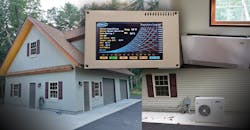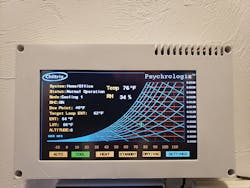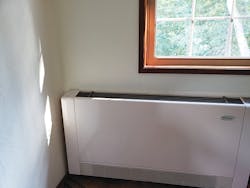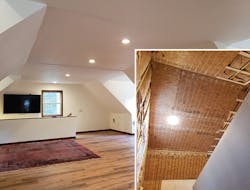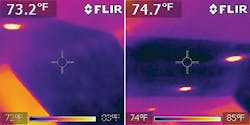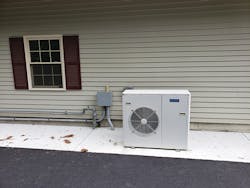This is a 2017 test site installation performed in a wood frame house (including garage, workshop and upstairs apartment) located in Carlisle, MA. The system has been in operation for the past two winters and summers under New England weather conditions (which, for those who don’t know, are hot and humid in the warm months, cold and snowy in the cool ones).
The first step was to perform a computation of the heating and cooling load for the space. This particular home had all-fiberglass insulation, with walls and ceiling R19, roof R32.
For what I’m calling in this article a “hydronic HVAC system,” the best place to locate the tubing panels is typically the walls and ceilings. For a typical installation, the entire ceiling should be covered with tubing panels and, if necessary some additional wall spaces. BTU output per panel (10 sq. ft.) at a water temperature of 100°F is approximately 120 BTU/hr. (If not enough sq footage of panel output is available, an additional fan coil unit is an option.)
As a rule of thumb, try to cover the entire ceiling with panels to deliver the proper square footage of radiation; this is the key for system efficiency in conjunction with heat pumps. The more radiant surface the better, since it will guarantee the lowest heating water temps as well as the highest chilled water temps possible.
After tubing insertion and before sheet rock or plaster board installation, aluminum foil was attached to the grid panels via spray adhesive. This promotes the cooling radiant effect downwards. Conducting heating radiation downwards is a good alternative to floors as well, which makes the ceiling the best location for a combination panel system such as this one. It keeps the overall system cost in check, while performing both functions.
There are any number of considerations to keep in mind in a combination heating/cooling hydronic system such as this one.
A small buffer storage tank is definitely recommended for overall smooth system operation.
Additional super quiet flat panel heating/cooling units can be added where needed for additional output and fast recovery on both heating and cooling functions.
If a domestic hot water system needs to be integrated, the buffer tank needs more storage capacity with tank sizes of 37 or 70 gal. and a built-in heat exchanger (in this case a Chiltrix VCT or HCT Series) for potable water. Otherwise a separate water heater is recommended, which will simplify the whole system design.
In case the buffer tank is supplying DHW, a mixing valve needs to be installed between the buffer tank and the HVAC manifolds.
A functional tubing grid system is essential for equal heating and cooling water distribution in the ceiling and or walls.
Panels must be easy to install over joists and studs and existing sheet rock as well as concrete and concrete blocks to receive small diameter tubing.
Tubing spacing should not exceed 4.5", and circuit length not to exceed 150 feet for 5/16" diameter ID tubing.
Small diameter oxygen Barrier PEX tubing with small tubing spacing and short circuits is essential and reduces both the dew point and condensation.
Tubing must tidally snap into panel grooves for secure mounting.
To keep material cost down, manifold balancing valves can be eliminated by piping the manifold supply and return in “reverse return” fashion back to the circulator. However purging system air during the initial fill becomes a little more challenging.
The supply and return between the Heat Pump Chiller can also be piped with PEX Barrier tubing. Copper or aluminum PEX rigid pipe is an option.
To prevent surface condensation, additional measures must be taken in geographical areas of high humidity conditions, with RH of 60% and higher. In this application the heat pump chiller was equipped with an additional dew point controller to ramp up the water temperature during high humidity levels. In addition, we installed a Honeywell dehumidifier to keep the air at RH of 50% or lower. However, the CXI fan coil units we used can also be used as dehumidifiers.
We never observed any ceiling surface condensation or wet equipment (such as metal tubing, circulators or manifolds) even under outside conditions of 90% RH.
Under extreme outdoor temperatures of below minus 20°F our supply water temperature never exceeded 90°F. And at plus 95°F outdoor temperature Chilled water temp. of 48°F with a return of 57°F was the extreme. Surface temps of the plasterboard was 65°F, maintaining 72°F room temperature. In reverse for the heating mode we never observed water temperatures above 90°F.
These low water temperatures are essential for the heat pump’s efficiency, especially at outdoor conditions under 32°F. A small, wall hung, electric boiler can be piped in series with the heat pump.
Necessarily high and low operating water temperatures are possible due to the large unobstructed ceiling surface areas providing us with an ideal square foot area which allow water temps. almost approaching room temperature set points.
The typical Delta T between heating supply and return is 10°F, and chilled water temp. return and supply 10°F under design conditions.
Zone control can easily be achieved by either circulator or manifold zone valves.
Equipment List
• Heating/cooling source: Chiltrix Air to Water Heat Pump Chiller CX34 : 3 Tons heating and 2 Tons Cooling
• Control system: Chiltrix Psychrologix (check out www.chiltrix.com for control sequence), Honeywell Humidistat and Thermostats
• (Optional) High efficiency chiller fan coil units: CXI 120, 12,000 BTU cooling and 10,000 BTU heating
• Buffer Tank: 19 Gallon Stainless Steel by Chiltrix
• De-humidifier: Honeywell model # DR 65 with Humidistat # H6062 A 1000
• Circulators: Grundfos UPS 15-58FC3-speed per manifold
• Distribution Manifolds: 1” Stainless Steel
• Zone control: circulators controlled by Honeywell thermostats.
• Tubing suppliers: Uponor and Viega.
• Tubing distribution system: 5/16” PEX Tubing with Oxygen Barrier
• Tubing mounting grid system: Hydronics Mfg. UNI-Panels for Ceilings and Walls, ½”X32”X48” with tubing spacing of 4.5” on center and snap in grooves for secure tubing mounting.
• Antifreeze solution: 10-20% of heating system-rated polypropylene glycol.
• Heating/Cooling transfer sheeting: 6 mil aluminum foil
For additional information please check www.Hydronicsmfg.com. For more info please email [email protected]. Hydronics Manufacturing is a supplier of the Uponor QuikTrak panel and the Viega Climate Panel system. Chiltrix (www.Chiltrix.com) was the supplier of the heat pump chiller equipment for this project.
Joe Fiedrich is a former hydronic heating columnist for CONTRACTOR. He was the president of Stadler Corp., which is now part of Viega North America, and he is the inventor of the Viega Climate Panel and Uponor Quik Trak. He is now President/CEO of Hydronics Manufacturing Inc.
About the Author
Joe Fiedrich
Joe Fiedrich is a former hydronic heating columnist for CONTRACTOR. He was the president of Stadler Corp., which is now part of Viega North America, and he is the inventor of the Viega Climate Panel and Uponor Quik Trak. He can be reached at [email protected]. Also, visit his company Hydronicsmfg.com.
